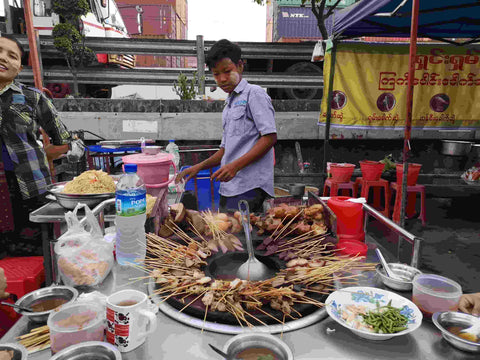Everything You Need To Know About Burmese Food, With MiMi Aye
by Holly Thomson


“In Burma, rice is life. We don’t ask each other ‘Have you eaten today’, we say ‘Have you eaten your rice yet?’ Our everyday food is along the lines of the ‘rice table’ – you have rice with lots of trimmings, sides and soups and you eat everything at the same time.
What are the most famous Burmese dishes?
Our national dish is actually a noodle broth dish, called Mohinga. It’s a breakfast recipe, in the same way Vietnamese pho is made with catfish and lemongrass. It’s lovely. It’s served with lots of garnishes – a crispy fritter on top, duck eggs, coriander and chilli.
Mohinga is normally sold by people on bicycles. With little stacks of bowls. Or if we wanted a takeaway we’d take a tiffin tin, and the seller would make up the meal in the different compartments – to make sure the crispy bits stayed crispy.

Our most iconic dish is probably pickled tea leaf salad. You take the pickled leaves as a base, then add crunchy things, sour things and savoury things. The idea is to make a really interesting spoonful.
I think eating tea leaves is pretty much unique to Burma. Although there’s one place in China that has a tea leaf dish called ‘thunder tea’, made with cooked tea and boiled rice.
The closest thing to tea leaves in terms of flavour are deli-style artichokes. The leaves are fermented and preserved, so it’s got that same savoury bite and astringency.
What food would you make for a Burmese celebration?
Danbauk. It’s a rice dish which is often slightly lazily translated as biriyani (even by me!) but it bears more relation to Iranian rice. It’s a bit like plov, or pilau. It’s a fragrant spiced rice usually made with chicken, and you serve it with little side dishes, such as sour soup, cabbage and mint salad, and a little dry, crispy relish.
The idea is that all goes together in one spoonful to create the ideal balance of tastes and textures. I served danbauk at my wedding.
Do lots of the dishes have garnishes and side dishes?
Yes, the Burmese are great believers that everyone has a different palate. So you can adjust everything to your taste with garnishes. For instance, chillies will always be on offer, but you can choose if you want them.
We love our chillies raw, pickled, roasted or whole dried and fried (sort of Mexican style). There is always heat on offer but depending on the dish the type will change, and you can choose if you’d like it. Hence, children will be served the same meal as adults, as it's not automatically spicy.
How about fruit and veg?
Burmese salads are really hearty things, they’re not just leaves. Think tomatoes, onions, beans, tofu, pickled prawns, mango, papaya – all chopped up. You can eat them as a snack, or with rice. It should be an explosion of texture and flavour – a forkful will really wake you up.
And there are so many different fruits in Burma. We don’t have a huge number of indigenous desserts (many puddings are Indian or Malay-influenced with e.g. their use of coconut), and I think it’s because we have so much fruit to choose from.
My parents recently returned from Burma with a photo of a fruit that looks like a potato, but you slice it open and it tastes like a pear. It's a member of the jicama family, but I’d never even seen or heard of it before.

Tell us about the famous Burmese street food!
Street food is huge. Although more so in Mandalay than Yangon. When they opened up Yangon to tourism they decided to clean up the streets, and lots of street food was lost. You still find it in Yangon but it tends to be off the street in roadside cafes. In Mandalay though the street food is everywhere and it’s normally portable.
You have people on bicycles or walking. When we visited my grandparents in Burma my favourite Mandalay Meeshay (a rice noodle dish) seller would trundle along the road with something that looked like a beer barrel on wheels, and an elaborate sewing box-style crate with all the ingredients in different compartments.

There’s a brilliant pork dish that was invented by Chinese vendors in Burma about 30 years ago and is now really popular – called wet-thar doke htoe. It’s basically all the parts of the pig – intestines, belly, everything – but flavoured with five-spice which was a new thing to Burma.
The pork comes on a skewer (the name actually means "pork skewered"), and you’re charged per stick that you eat. Some dodgy characters, including my cousins, would always try and hide the odd stick!
And one of my other favourite dishes is the Indian-inspired samosa salad. It’s samosas moulded to the Burmese taste, chopped up and turned into a salad.
There are lots of Indian and Chinese influences on the street food, as there are brilliant communities in Burma. One of my favourite places to go in Mandalay is China Town.
Can you describe the typical Burmese kitchen?
Firstly, we don’t have ovens. A traditional kitchen would be open, and outside the house in a slightly separate building. That’s where you’d have your wood or charcoal burning stove, the woks and all your pans.
Nowadays people tend to use a hob ring almost like camping stoves. But we still don’t really have ovens. My mum remembers they had to bury the fire cinders every day when she was small, because they didn’t have a proper stove, so needed to make sure the house didn’t burn down each night!
The thing that makes me most think of Burma is the smell of wood burning and charcoal, it’s just in the air. I have real flashbacks to Burma on Bonfire Night...
Essential Burmese Food
-
Ngapi, which is our version of shrimp paste. It appears in loads of recipes, including some you wouldn’t expect. It’s generally made from small fry fish, not shrimp, and I think it developed mainly because the Irrawaddy river is a huge part of Burma and basically all the population clusters around it. So the fish paste features in everything. It tastes very similar to shrimp paste, so I use the latter as a substitute.
-
Onions. We are the largest consumer of onions per head – they go into everything, curry bases, soups, salads. Basically If you don’t have a sack of onions in your kitchen, are you even cooking Burmese food?
-
Turmeric is popular for its bittersweet flavour and fragrance, as well as for health reasons. Ground turmeric is used to marinate fish, seafood or meat, as a key spice in many curries, and is also found in chutneys and pickles. Turmeric oil (i.e. oil seasoned with turmeric) is used to dress salads and noodles.
Feeling inspired? Read MiMi’s guide to celebrating Burmese New Year Thingyan here, or take a look at the selection of Southeast Asian ingredients available at Sous Chef.



